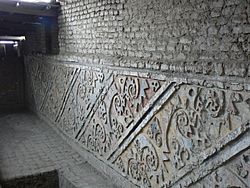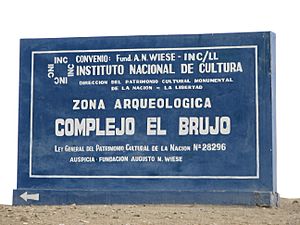El Brujo facts for kids
Quick facts for kids El Brujo |
|
|---|---|

Bas-relief patterns at Huaca El Brujo
|
|
| Location | |
| Nearest city | |
| Established | Mochica era |
The El Brujo Archaeological Complex is an amazing ancient site in Peru. It is located north of Trujillo, in the Chicama Valley. People have lived and built here since very old times, even before pottery was invented!
This special place shows us how different cultures lived over thousands of years. The oldest part is called Huaca Prieta. But the biggest buildings were made by the Moche culture. Later, the Lambayeque and Chimú people also used this area.
Contents
Ancient Moche Buildings
During the Moche era (around 200 B.C. to 600 A.D.), El Brujo became a very important place. The Moche people built huge religious and political centers called huacas. These huacas were like temples and special gathering spots.
Archaeologists believe these buildings were used for ceremonies, rituals, and burials. Powerful leaders, sometimes called caciques, organized the people to build them. Even though the weather could be tough, the Moche built impressive structures.
The Three Main Huacas
The El Brujo complex has three main huacas:
- Huaca Prieta: This is the oldest mound, dating back to pre-pottery times.
- Huaca Cortada: This is a large pyramid with steps.
- Huaca Cao Viejo: This is the biggest pyramid at the site. It also has steps.
Scientists have found that Huaca Cao Viejo was built in seven different stages. This shows how important it was to the Moche people over many years.
Huaca Cao Viejo's Secrets
Huaca Cao Viejo is famous for its colorful carvings and paintings on the walls. These artworks tell us stories about the Moche people's beliefs and daily life.
In 2004, something incredible was found here: the tomb of the Señora de Cao. She was a powerful female ruler from the Moche culture. Her discovery was very important because it showed that women could hold high positions in ancient Peru. Her story was even featured in National Geographic magazine!
The El Brujo site officially opened to visitors in 2006. A museum was also planned to show off the amazing discoveries.
After the Moche Culture
The Moche people eventually left the huacas. This might have happened because of political problems or extreme weather changes. Scientists are still learning more about why the Moche culture declined.
However, El Brujo remained a special place. The Lambayeque Culture arrived around 900 A.D. Later, the Chimú and Inca empires took over the area. But El Brujo was still used for ceremonies and burials, keeping the memory of the past alive.
A Clue to Old Languages
In the 1600s, a letter was found during excavations at El Brujo. This letter might contain numbers written in a language called Quingnam or Pescadora. This could be the first real proof that these languages existed!
Archaeologists think these languages might have been influenced by Quechua. Quechua is an ancient language that millions of people still speak today in the Andes mountains.
See also
 In Spanish: El Brujo (sitio arqueológico) para niños
In Spanish: El Brujo (sitio arqueológico) para niños



